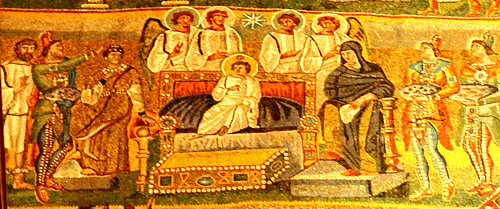The Adoration of the Magi

5th century
Mosaic
Triumphal arch, Basilica of Santa Maria Maggiore, Rome
Christian commentators often wrote of the Magi as seeing not only a human baby in his mother's arms but the Son of God in his majesty: "The lowliness of the assumed Body is before their eyes, yet the glory of the Divinity is not concealed."1 Most images of the Adoration of the Magi give a literal rendering of Matthew 2:11, but this one aims to present "the glory of the Divinity." The child sits directly beneath the star in a toga on a capacious and bejeweled throne, attended by four angel courtiers, also in togas. The halos on all five, absent on the human figures, mark them off as heavenly beings.
The child is flanked by two female figures on lower thrones. On his left is Mary in a simple blue mantle, as one's bodily eyes would have seen her: "not crowned with a diadem or lying on a golden couch; but with barely one garment, not for ornament but for covering, and that such as the wife of a carpenter when abroad might have," as a 5th-century pope put it (Catena Aurea, I, 76). But the woman on his right is also Mary, her portrait a duplicate of the Annunciate in the panel above this one. This is Mary in the perspective of eternity, "Maria Ecclesia," wearing the same pearl collar as the virgin martyrs in the portraits in the Euphrasian Basilica and at St. Praxedes in Rome.
The portrayal of the Magi has a similar doubling of the corporeal and the spiritual. As men "from the East" (Matthew 2:1) they wear trousers and Phrygian caps. But as visitors to the heavenly court they represent secular authority affirming God's preëminence. It was in the 5th century that it was first suggested that the Magi were kings.2 Their red shoes and the jeweled clasps on their copes are modeled on the garb of the Emperor. The two standing on the right hold the gifts on large gold plates, like the missoria associated with gifts from the Emperor. Instead of bowing as the gospel specifies, the mage on the left lifts his right arm in the Roman gesture of acclamation.3
The space these figures occupy also combines what the eye sees with what the mind discerns. The people stand on what appears to be earthly grass, but the land behind them is portrayed as a wide band of heavenly gold.
The Magi narrative does not mention Joseph, so commentators assumed that he was not there.4 Yet here he is on the far left of the panel. In the tunic and sandals of a common worker he looks out at the viewer and makes a gesture of acceptance.5 As a humble man who accepts the truth of this epiphany even though he was not there, he serves as a model for the viewer.
This emphasis on the child's divinity is unlike anything done in Magi images before or since. It may be that it was meant to affirm the "catholic" theology prevalent in Rome – that the Son of God is coeternal with the Father – as against the Arianism of Italy's Germanic rulers, who held that he "was originated, and once had not existed."6
This image forms the second register of the mosaics on the left side of the arch. On the right side there is also a mosaic of the Magi's consultation with Herod.
View the entire left side.
View the entire arch.
Read more about the Adoration of the Magi.
Photographed at the basilica by Richard Stracke, shared under Attribution-NonCommercial-ShareAlike license.
1 John Chrysostom, "Sermon on the Epiphany," in Toal, I, 224. Further statements along this line may be found in the Catena Aurea, I, 75-77.
2 Glossa Ordinaria, V, 59.
3 For the red shoes, see for example this image of Justinian I from Ravenna. The round fibula (clasp) with a circle of pearls around a larger gem is a feature of many imperial portraits such as this missorium. For the gesture of acclamation, compare this detail from the Column of Trajan.
4 See quotations from Remigius in the Catena Aurea (I, 76) and from Augustine in the Glossa Ordinaria (V, 62).
5 For other examples of the palms-out gesture of acceptance, see our study of the Annunciation and this image of Peter listening to the angel.
6 Catholic Encyclopedia, s.v. "Arianism."